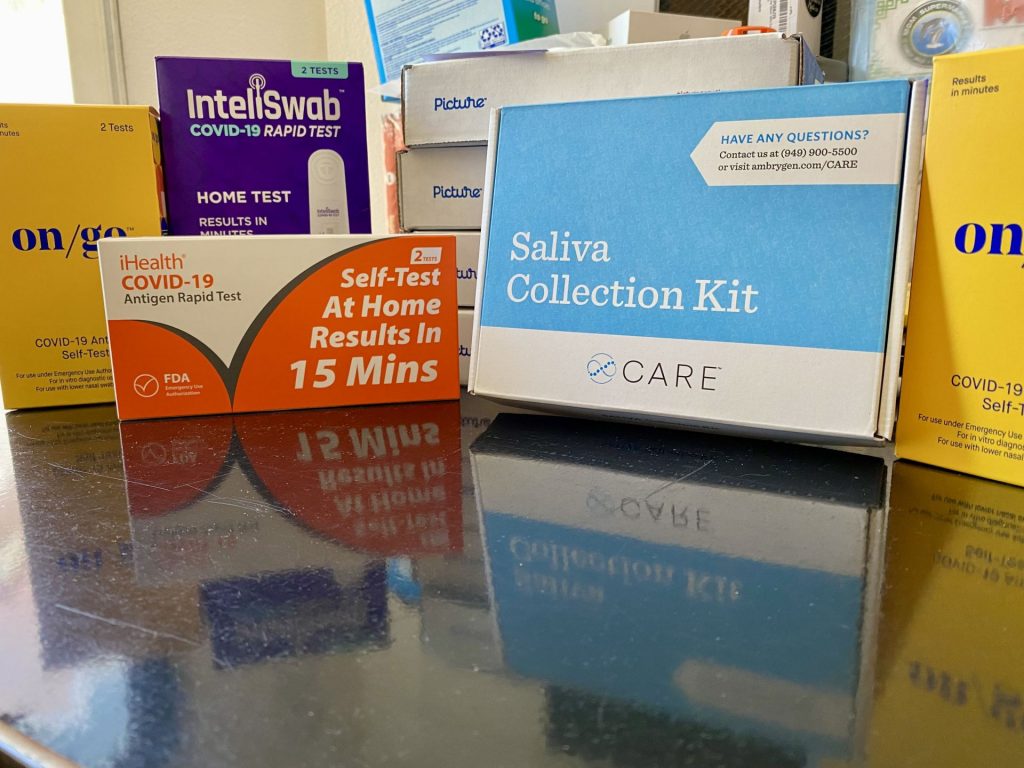
Testing the Tests, Santa Ana, 2022
Annie Phan
With the surge of covid cases from the omicron variant, the demand for covid tests followed, especially as the holiday season began. In this image, it is my family’s current collection of covid tests collected over a three month period. My family is lucky enough to have access to covid tests. As my father works in the healthcare manufacturing sector, he is able to order rapid tests, specifically the On/Go and Inteliswab tests. As I work at mobile vaccine clinics, I am able to get PCR covid tests from local community organizations. My other job at the local high school I work at also gave me the iHealth rapid test as it was distributed to all students and employees.
As this stockpile began, many issues regarding covid tests surfaced. The accessibility for covid tests had many barriers, such as demand rising yet supply decreasing. This led to the increase in the price for rapid tests bought at local pharmacies. Despite being such a pivotal part in the pandemic, many of the rapid tests were pricey. For me, I was lucky enough to receive these tests for free. However, if I had to pay for them on my minimum wage salary, I wouldn’t have enough to buy any of the tests after covering my basic necessities. Another issue is the lack of in-language resources available for the test. Each test kit contains English instructions while some contain Spanish instructions. This makes the usage of the test difficult for my parents who haven’t had experience learning about common laboratory tests and methods. Due to that, I have become a test administrator for them.
Each time they do a test at home, I set up all their accounts as my parents are not technologically savvy. Whether it be a nasal swab or a PCR sputum test, I would have to either stick the swab in my parents’ nose and prepare the reagent liquids. I am sure this is not an isolated experience for myself only, but it reminded me of my childhood where I would have to call AT&T at 10 years old to fix the internet. The main similarity from both those experiences is that there was a language barrier. Non-English speaking communities are often lost in translations. It is not easy to find culturally competent materials about COVID self tests or even about COVID in general. Many community organizations have been able to translate covid resources to their communities’ dominant language. Even then, there are difficulties as translations can lose the nuances behind the words. This can be easily combated by focusing on thorough processes that can provide in-language materials for non-English speaking communities.

Collective Individual, Santa Ana, CA, 2022
Annie Phan
A small table filled with miscellaneous objects; some needed for daily life, others forgotten. In the middle of the table was my much needed chocolate stash for stress relief and the masks I wore in the house outside my room. The back row of the table had a row of various alcohol wipes and towels. The left side of my table is my year long supply of contacts, ordered specifically to make my life easier while wearing masks. The biggest thing on the side was my humidifier which was also filled to assist me in my raging battle with sinusitis. However, the story behind this image starts with the hot sauce and ketchup packets lying in the front of the table. The sauce packets came from a trip to Del Taco with my sister on December 28. On the ride home, I received a text from a former teacher who I met the day before. They informed me they were a close case to a positive case whom they met before me recently. The atmosphere in my car dropped and my anxieties skyrocketed. I immediately wore my mask on the drive home and dashed into my room, asking my sister to deliver the food to my door.
For the next week, I experienced what many individuals went through as they isolated themselves away from their families. Food was brought up to my room and dishes were left outside my door when I was finished. Though I consider myself to be a homebody, the isolation experience was far from what I was expecting. It was difficult to seclude myself in my room. I was comfortable physically but not mentally. It felt like a prison; my legs were eager to escape the room. The most overpowering feelings were guilt and dislike. Despite taking all precautions during the holiday season to protect myself and my family, I still managed to put myself at risk. I felt guilty for troubling my family because I had to stay in my room. If I did get covid, it felt like it was a reflection of me not doing enough to protect myself or my family. Luckily, I tested negative after isolating for a week.
Through this experience, I came to many realizations. I was lucky enough to have my own room to quarantine in. This is not the experience for many others, especially multigenerational households. More often than not, these households have multiple people occupying a room. Two of my cousins share the same room due to lack of space. There is a greater burden from COVID-19 in multigenerational households as transmission of the virus is easier. There needs to be better guidance for multigenerational households to prevent the spread of COVID and to recover safely from it. This can be done by providing equitable resources to this population and vary from economic support and places to help isolate at.